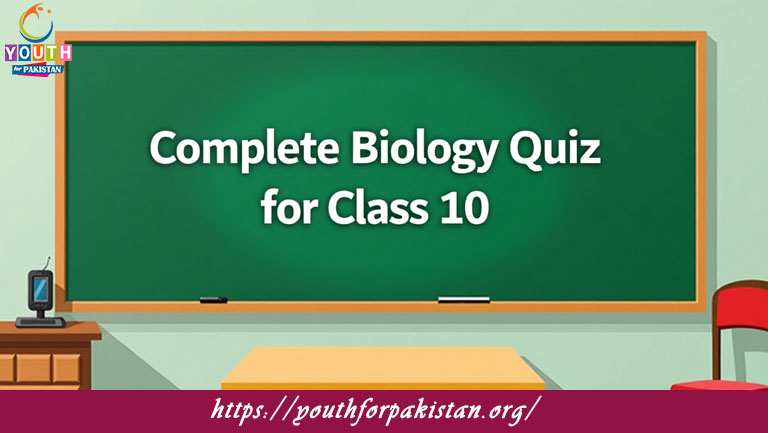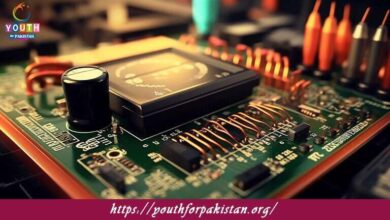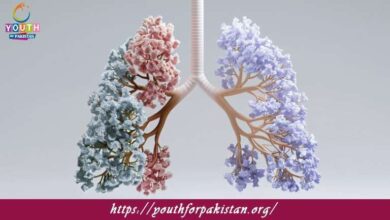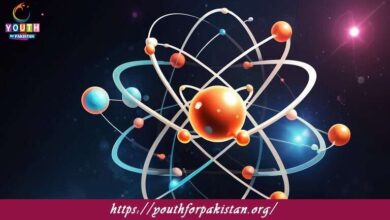10th Class Biology Complete Quiz Test

10th Class Biology Complete Quiz is one of the most important subjects for MDCAT aspirants, as it deals with the study of life and the complex processes that sustain it. The 10th Class Biology Complete Quiz is designed to help students strengthen their concepts in essential topics such as homeostasis, coordination and control, reproduction, and inheritance. This quiz provides a comprehensive revision of the syllabus, preparing students for both their academic exams and entrance tests like MDCAT.
Key Topics in the 10th Class Biology Quiz
The 10th Class Biology Complete covers key topics such as support and movement, hormonal control in humans, nervous system, and transportation in plants and animals. Moreover, the quiz includes questions on reproductive health, genetics, evolution, and biotechnology—all very important for MDCAT Biology.
By attempting this quiz, students can identify their weak areas and improve their problem-solving abilities. The questions are designed to enhance critical thinking skills and deepen conceptual understanding, which is very important for attempting the complex multiple-choice questions seen in the MDCAT Biology section.
Quiz for Practice
Get the best quality, exam-relevant questions. Frequently tested topics from past papers; including basic and advanced concepts. Practicing these quizzes enables students to improve their time management, accuracy, and analytical thinking. Continuing the quiz practice regularly is also essential for the competitive exams.
- Test Name: 10th Class Biology Complete Quiz
- Total Questions: 240
- Total Marks: 240
- Time: 120 minutes
Note: Answer of the questions will change randomly each time you start the test, once you are finished, click the View Results button.
Free Flashcard for Quick Revision
Students may also view free flashcards to quickly revise important terms, definitions, and biological processes from the 10th Class Biology syllabus. These flashcards are quite useful during last-minute preparation and make the recalling of such important biological concepts as cell division, photosynthesis, hormonal regulation, and genetic inheritance very easy. Flashcards help in retaining the information in the long term and ensure that students answer questions confidently during the exams.

Which biotechnological application involves the use of genetically modified microorganisms to clean up environmental pollution?
Bioremediation

Which enzyme is responsible for adding nucleotides to the growing DNA strand during DNA replication?
DNA polymerase

Which biotechnological technique is used to identify and analyze specific DNA sequences in a sample?
DNA fingerprinting

What is the term for the specific sequence of DNA that codes for a particular protein or RNA molecule?
Gene

In gene therapy, what is the primary goal of introducing a therapeutic gene into a patient's cells?
Treat or cure a genetic disorder

Which type of RNA carries the genetic information from DNA to the ribosome for protein synthesis?
Messenger RNA (mRNA)

Which technique is used to transfer genes into animal cells by using an electric field to create temporary pores in the cell membrane?
Electroporation

Which technology allows scientists to determine the order of nucleotides in a DNA molecule?
DNA sequencing

What is the name for the specific sequence of DNA where RNA polymerase binds to initiate transcription?
Promoter

In genetic engineering, what is the purpose of introducing a reporter gene?
To track the expression of other genes

Which term refers to the study of an organism's complete set of genes and their interactions?
Genomics

What is the function of the Cas9 protein in the CRISPR-Cas9 system?
Cuts DNA at specific target sequences

Which enzyme is responsible for synthesizing a complementary RNA strand during transcription?
RNA polymerase

What is the role of reverse transcriptase in the process of reverse transcription?
Synthesizes complementary DNA (cDNA) from mRNA

Which type of genetic modification involves the direct editing of an organism's DNA using CRISPR technology?
Genome editing

In genetic engineering, what is the name for the introduction of a new or modified gene into an organism's cells?
Gene transfer

Which biotechnological application involves the production of genetically identical copies of a gene or DNA sequence?
Cloning

What is the role of a selectable marker in genetic engineering?
Identifies cells that have taken up foreign DNA

Which technique is used to introduce foreign genes into plant cells by using a bacterium as a vector?
Agrobacterium-mediated transformation

Which type of RNA molecule carries amino acids to the ribosome during protein synthesis?
Transfer RNA (tRNA)

What is the name for the process of creating a genetically identical copy of an organism by replacing the nucleus of an egg cell?
Nuclear transfer

Which term refers to the selective breeding of plants and animals to enhance desirable traits?
Selective breeding

In the context of genetic engineering, what does CRISPR stand for?
Clustered Regularly Interspaced Short Palindromic Repeats

What is the term for the process by which an organism adjusts its internal conditions to maintain a stable internal environment?
Homeostasis

In which biome would you find a diverse array of plant and animal species, high rainfall, and high temperatures year-round?
Tropical rainforest

Which term refers to the gradual increase in the Earth's average temperature due to human activities?
Global warming

What is the primary role of decomposers in nutrient cycling?
Break down organic matter into nutrients for reuse

Which process involves the conversion of light energy into chemical energy in the form of glucose during photosynthesis?
Calvin cycle

What is the term for the range of conditions under which a species can exist and reproduce?
Tolerance range

Which environmental issue is associated with the accumulation of non-biodegradable pollutants in the food chain?
Biomagnification

Which type of pollution is caused by excessive nutrients in water, leading to algal blooms and oxygen depletion?
Eutrophication

What is the term for the process by which water changes from a liquid to a gas, primarily from the surface of water bodies?
Evaporation

What is the term for the process by which water vapor is released from plants into the atmosphere?
Evapotranspiration

What is the term for the process of water moving from the atmosphere to the Earth's surface through precipitation?
Precipitation

In which biome would you find a high density of evergreen trees adapted to cold temperatures and acidic soils?
Taiga (Boreal forest)

Which environmental issue is associated with the excessive use of fertilizers, leading to nutrient runoff and water pollution?
Eutrophication

Which process involves the conversion of nitrates into nitrogen gas, returning it to the atmosphere?
Denitrification

What is the term for the total mass of living organisms in a particular area at a given time?
Biomass

Which atmospheric layer contains the ozone layer that protects life on Earth from harmful ultraviolet radiation?
Stratosphere

Which ecological relationship benefits one organism while neither harming nor benefiting the other?
Commensalism

Which term refers to the maximum number of individuals that an environment can support?
Carrying capacity

What is the name for the process of converting sunlight into chemical energy in plants?
Photosynthesis

Which scientist proposed the theory of inheritance through the transmission of acquired characteristics?
Jean-Baptiste Lamarck

In a Punnett square, what represents the possible genotypes produced by the union of gametes?
Intersections

Which law states that each pair of alleles segregates independently of other pairs during gamete formation?
Law of Independent Assortment

Which genetic disorder is characterized by the absence of an enzyme needed to break down lipids, leading to the accumulation of fatty substances in the brain?
Tay-Sachs disease

What is the expected phenotypic ratio in the F2 generation of a dihybrid cross between two heterozygous individuals?
9:3:3:1

In a test cross, what is the purpose of crossing an individual with an unknown genotype with a homozygous recessive individual?
To determine the genotype of the unknown individual

Which genetic disorder results from the inability to produce melanin, leading to a lack of pigmentation in the skin, hair, and eyes?
Albinism

Which scientist discovered the principle of genetic linkage by studying fruit flies?
Thomas Hunt Morgan

What is the probability of having a child with a dominant genetic disorder if both parents are affected (homozygous)?
0.5

What is the term for an individual who carries one copy of a recessive allele for a genetic disorder but does not express the trait?
Carrier

Which inheritance pattern involves the expression of both alleles in the heterozygous condition?
Codominance

In a monohybrid cross, what is the expected phenotypic ratio of the F2 generation if both parents are heterozygous?
0.12569444444444

What is the probability of having a child with a dominant genetic disorder if one parent is affected and the other is unaffected (heterozygous)?
0.5

Which scientist is known as the "father of modern genetics" for his work on the inheritance of traits in pea plants?
Gregor Mendel

In codominance, what is the result when two different alleles for a gene are both expressed in the heterozygous condition?
Both traits are fully expressed

Which genetic disorder is caused by the absence of an enzyme needed to break down phenylalanine?
Phenylketonuria (PKU)

What is the term for the genetic makeup of an organism, including both expressed and unexpressed alleles?
Genotype

Which law states that pairs of alleles segregate independently during the formation of gametes?
Law of Independent Assortment

Which method of contraception prevents sperm from reaching the egg by blocking the cervix?
Cervical cap

What is the function of the placenta in pregnancy?
Facilitates nutrient and waste exchange between mother and fetus

Which male reproductive organ produces a fluid that neutralizes acidity in the urethra?
Prostate gland

What is the term for the period of time when a woman ceases to have menstrual cycles, marking the end of reproductive years?
Menopause

Which hormone is responsible for the development and maintenance of male secondary sexual characteristics?
Testosterone

What is the function of the uterine lining (endometrium) during the menstrual cycle?
Nourishes and supports a potential embryo

Which stage of development follows the blastocyst and involves the formation of three germ layers?
Gastrulation

What is the purpose of the acrosome in a sperm cell?
Contains enzymes to penetrate the egg's outer layer

Which method of contraception involves the blocking or sealing of the fallopian tubes?
Tubal ligation

What is the purpose of the chorion in the developing embryo?
Forms the fetal part of the placenta for nutrient exchange

What is the function of the seminal fluid in the male reproductive system?
Provides nutrients and a medium for sperm transport

Which method of contraception involves the insertion of a small, T-shaped device into the uterus?
Intrauterine device (IUD)

What is the role of the corpus luteum in the female reproductive system?
Producing progesterone to maintain the uterine lining

What is the purpose of the cervix in the female reproductive system?
Acts as a passageway between the uterus and the vagina

Which method of contraception involves the removal of a segment of the vas deferens in males?
Vasectomy

What is the term for the early developmental stage of the fertilized egg before implantation in the uterus?
Blastocyst

Which hormone is known as the "pregnancy hormone" and is detected in pregnancy tests?
Human chorionic gonadotropin (hCG)

What is the function of the fallopian tubes in the female reproductive system?
Transporting eggs from the ovaries to the uterus

What is the term for the union of a sperm and egg outside the body, typically in a laboratory setting?
In vitro fertilization (IVF)

Which method of contraception prevents the release of an egg from the ovary?
Oral contraceptives (birth control pills)

What is the role of the Cowper's glands in male reproduction?
Producing a lubricating fluid before ejaculation

What is the function of the seminal vesicles in male reproduction?
Producing seminal fluid rich in nutrients

What is the purpose of the spongy bone in the structure of bones?
Provides strength with reduced weight

What is the function of the sarcomere in muscle contraction?
The basic contractile unit containing actin and myosin

What is the term for the tough, fibrous connective tissue that surrounds joints and provides support?
Joint capsule

What is the function of the Haversian canals in compact bone?
Allow blood vessels and nerves to travel through the bone

What is the purpose of the foramen magnum in the skull?
Allows the spinal cord to pass through and connect to the brain

Which connective tissue covers the ends of bones in a joint and reduces friction?
Articular cartilage

What is the term for the point of contact between a motor neuron and a muscle fiber?
Neuromuscular junction

What is the function of the periosteum in bone structure?
Provides nutrients and serves as a site for tendon and ligament attachment

What is the purpose of the muscular system in the human body?
Movement, stability, and heat production

Which hormone plays a crucial role in regulating calcium levels in the blood and bone?
Parathyroid hormone (PTH)

What is the purpose of the vertebral column in the human body?
Supports the body and protects the spinal cord

Which part of the ear amplifies sound waves and transmits them to the inner ear?
Middle ear (ossicles)

What is the function of the medulla oblongata in the brain?
Controlling basic bodily functions like heartbeat and breathing

What is the term for the bundle of nerves that carries signals between the brain and the rest of the body?
Spinal cord

What is the role of the hypothalamus in the endocrine system?
Regulating hormone release from the pituitary gland

What is the purpose of the autonomic nervous system?
Controlling involuntary bodily functions, such as heartbeat and digestion

What is the role of the pituitary gland in coordination and control?
Regulating other endocrine glands and producing growth hormone

Which part of the brainstem is responsible for maintaining consciousness and alertness?
Reticular formation

What is the function of the pancreas in coordination and control?
Regulating blood sugar levels by producing insulin and glucagon

Which part of the ear is responsible for maintaining balance and spatial orientation?
Vestibular system

What is the term for the bundle of nerves that extends beyond the spinal cord and connects to the rest of the body?
Peripheral nervous system

Which part of the brain is responsible for higher cognitive functions such as thinking and problem-solving?
Cerebrum

What is the function of the cochlea in the ear?
Hearing and conversion of sound waves into nerve impulses

What is the purpose of the reflex arc in the nervous system?
Rapid, automatic response to stimuli without conscious thought

Which part of the nervous system controls involuntary functions such as digestion and heartbeat?
Autonomic nervous system

What is the function of the adrenal glands in coordination and control?
Producing hormones like adrenaline in response to stress

What is the term for the body's internal biological clock that regulates the sleep-wake cycle?
Circadian rhythm

What is the function of the corpus callosum in the brain?
Facilitating communication between the two hemispheres

Which component of the immune system plays a role in homeostasis by recognizing and attacking pathogens?
White blood cells

How does the body maintain fluid balance in response to dehydration?
Increased production of antidiuretic hormone (ADH)

What is the role of parathyroid hormone (PTH) in calcium homeostasis?
Increasing calcium reabsorption from bones

How does the body regulate salt levels in response to low sodium concentration?
Increased aldosterone release to retain sodium

What is the primary function of the spleen in homeostasis?
Filtering and removing old or damaged blood cells

How does the body regulate blood pressure through the baroreceptor reflex?
Increased heart rate and vasoconstriction

How does the body respond to an increase in blood sugar levels?
Release of insulin to facilitate glucose uptake by cells

What is the function of melatonin in the regulation of circadian rhythms?
Regulating sleep-wake cycles

What is the role of erythropoietin in maintaining homeostasis?
Stimulating red blood cell production in the bone marrow

How does the body regulate body temperature in response to cold environments?
Shivering and vasoconstriction

What is the primary function of the endocrine system in homeostasis?
Producing hormones that regulate various body functions

What is the role of glucagon in glucose homeostasis?
Stimulating the release of glucose from the liver

What is the primary function of the lymphatic system in homeostasis?
Draining excess fluid and fighting infections

What is the term for the process of maintaining a constant internal environment despite external changes?
Homeostasis

How does the body respond to a decrease in blood pressure?
Release of renin and activation of the renin-angiotensin-aldosterone system

What is the primary function of the thyroid gland in homeostasis?
Regulating metabolism and energy production

What is the primary role of insulin in glucose homeostasis?
Facilitating the uptake of glucose by cells

How does the body respond to a decrease in blood oxygen levels?
Increase in respiratory rate and depth

What is the primary function of the integumentary system in homeostasis?
Regulating body temperature through sweat production

Which hormone is responsible for regulating water balance by increasing water reabsorption in the kidneys?
Antidiuretic hormone (ADH)

How does the body regulate breathing rate during exercise?
Unchanged carbon dioxide and oxygen levels

Which respiratory center in the brain responds to changes in blood pressure?
Peripheral chemoreceptors

What is the term for the volume of air remaining in the lungs after a normal tidal expiration?
Inspiratory reserve volume

What is the term for the total volume of air that can be forcefully exhaled after a maximal inspiration?
Residual volume

Which respiratory center in the brain responds to changes in blood pH and carbon dioxide levels?
Baroreceptors

What is the term for the process of moving air into and out of the alveoli during ventilation?
Internal respiration

What is the primary function of the respiratory pigment myoglobin?
Carbon dioxide transport in the blood

What is the term for the exchange of gases between the blood and the tissues/cells?
Cellular respiration

What is the term for the amount of air that can be forcibly expelled after a normal tidal volume expiration?
Inspiratory reserve volume





